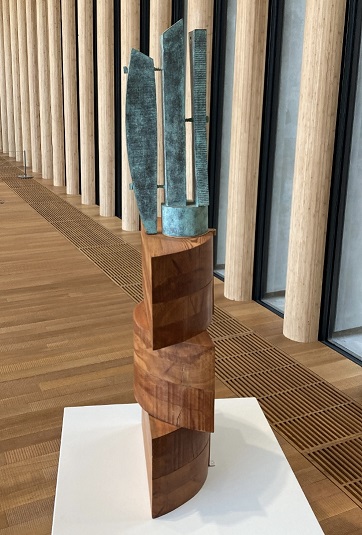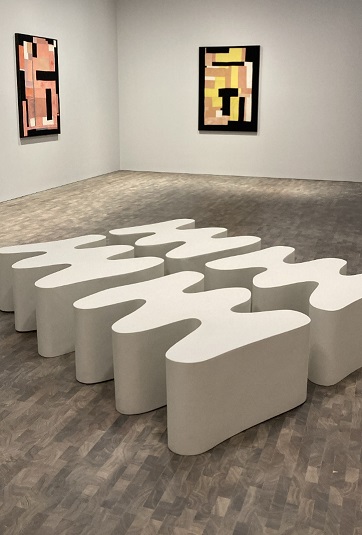In the South Galleries of Hong Kong’s M+ museum, a sculpture by Singaporean-British artist Kim Lim is on display as part of the survey exhibition, ‘Individuals, Networks, Expressions’. Centaur II (1963) sits amidst several sculptures in a space filled with natural light, thanks to floor-to-ceiling windows lining one side of the room. 6,000 miles away in London, another of Lim’s sculptures from the 1960s is positioned on the floor of Pace in Hanover Square. Trengannu II (1968) is part of ‘Creating Abstraction’, a multidisciplinary group exhibition of female artists. The concurrent display of these two sculptures offers a moment in time to consider them in unison, while their presentation on different sides of the world is symbolic of an international resurgence of interest in Lim’s work.
Born in Singapore, Lim moved to London to study art at Central Saint Martins before transferring to The Slade School of Fine Art. Her focus was on sculpture and print, valuing both mediums equally. Lim would journey back to Singapore frequently and travelled extensively around Asia and Europe, gleaning inspiration from European Modernism, ancient history and the natural world. The display of Centaur II and Trengannu II, one East and one West, offers a metaphor for Lim’s relationship with both regions, however, Lim was reluctant to make her identity an “issue” in her work, preferring what she did to be of importance, rather than who she was.[1]
Centaur II is a wood and bronze structure. The title, purporting to a mythical half man/half horse hybrid, illustrates Lim’s interest in the ancient world. Here, hybridity stems not through a literal representation of a centaur, but through the meeting of wood and bronze. Trengannu II features four identical, three-dimensional fibreglass blocks. The exact shape of the blocks evades geometry, but they are composed of three undulations on either side and are positioned in a rectangular formation. The title of the work, ‘Trengannu’, may relate to Trengganu Street in Singapore’s Chinatown and/or Terengganu in Malaysia, a country where Lim spent significant time during childhood.
“I would like my work to be able to infer experiences beyond the piece itself. Infer rather than refer to something specific and particular.”[2]
Both sculptures encompass Lim’s practice of creating reductive forms that are not explicit in their representation but rather infer a subject or feeling. In Centaur II, the ‘centaur’ has been stripped back to a concept, one of contrasting materiality, light and shadow and rich positive and negative space. The forms of Trengannu II, with its ambiguous title, evoke a sensation rather than a specific subject and conjure the feel of ripples or waves. Lim’s reductive approach to form provides space for us to ruminate on meaning.
Rhythm fascinated Lim and can be discerned in much of her work. The layers that comprise each wooden base block of Centaur II create a recurring line as they meet, and the stacking of the blocks – flat side front, curved side front, flat side front – suggest a sequence. On the bronze element, horizontal lines scored evenly into parts of the material create an understated rhythmic texture. On the other hand, Trengannu II’s four repeated shapes and sinuous undulations invoke rhythms found in the natural world. Lim reminisced on personal experiences which chime with this lyricism – beaches in Malaysia, where she witnessed the repetitive motions of a turtle burying its eggs in the sand in Terengganu and huge waves in Penang ‘that would come over and rise up like a wall’. [3]
There are a multitude of ways in which Centaur II and Trengannu II might be unpacked, both individually and together, attesting to Lim’s skill for imbuing layers of meaning into the simplest of forms. While her talent was relatively acknowledged during her lifetime, she has been absent from much Modernist art discourse since her death in 1997. Centaur II and Trengannu II’s display is symptomatic of a turn in the tide both East and West. In the last few years significant solo exhibitions have been hosted by the likes of Singapore’s STPI Gallery and London’s Tate Britain, amongst a number of group exhibitions. As of today, Lim’s works are on show as part of exhibitions at Whitechapel Gallery and the Barbican in London. Effort is being made to return Lim’s work to the fore and not only does this rightfully position her alongside her peers, but it allows for opportunities such as this – to meditate on her unique abstraction of form.
[1] “Being ‘female and foreign’ was never a problem as a student – later, I realised that there was a difference; but what was important in the end was what I did and not where I came from. Race and gender were givens I work from, perhaps the work does reflect this – which is fine – but I did not want to make them an issue.” Kim Lim, taken from an online tour of ‘Kim Lim: Carving & Printing’ by Bianca Chu, hosted by ArtSG. https://bit.ly/33QTYwI
[2] Kim Lim, taken from an online tour of ‘Kim Lim: Carving & Printing’ by Bianca Chu, hosted by ArtSG. https://bit.ly/33QTYwI
[3]National Life Stories: Artists’ Lives, British Library, Kim Lim Interviewed by Cathy Courtney. Lim mentions the turtles on page 69, and the waves in Penang on page 65. https://bit.ly/3shKuUB

